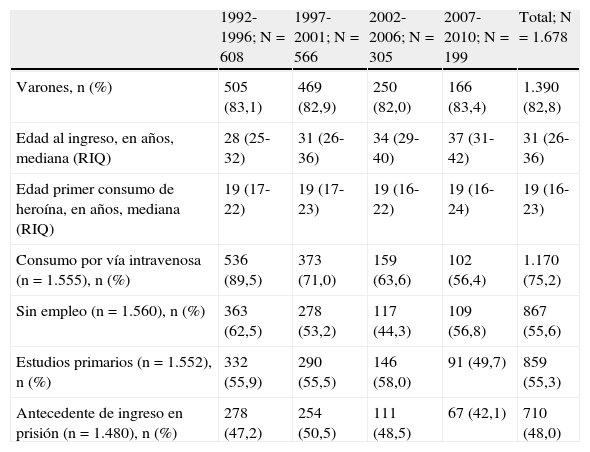La metadona es uno de los fármacos más utilizados en el tratamiento de la adicción a la heroína. El objetivo del estudio es analizar la experiencia de un programa de tratamiento de metadona desde su introducción en el área de Barcelona.
MétodoEstudio transversal en adictos a la heroína incluidos en tratamiento sustitutivo de metadona entre 1992 y 2010. Se analizan características sociodemográficas, de la drogadicción, prevalencia de infecciones por el virus de la inmunodeficiencia humana (VIH) y hepatitis B (VHB) y C (VHC), y comorbilidad psiquiátrica, según período de inclusión en el tratamiento.
ResultadosSe incluyeron 1.678 pacientes (82,8% varones). En el período 1992-1996 fueron incluidos 608 pacientes (36,2%), 566 (33,7%) entre 1997-2001, 305 (18,2%) entre 2002-2006 y 199 (11,9%) en el último período. La edad a la entrada en tratamiento aumentó de forma significativa (28 años en el 1992-1996 frente a 37 años en el último período [p<0,005]). El porcentaje de pacientes con historia de drogadicción intravenosa decreció significativamente (89,5% en el primer período frente a 56,4% en el último, p<0,05). La prevalencia de infección por el VIH, VHC y VHB (positividad para anticuerpos anti-core del VHB [HBcAc+]) fue del 53,7, 73,6 y 61,3%, respectivamente. En el análisis por períodos se observa una significativa disminución de la prevalencia de VIH (66,2% en el primer período y 43,5% en el último, p<0,05) y de VHC (82,8% en el primer período y 69,8% en el último, p<0,05). Un 25% de los pacientes tenían trastorno psiquiátrico; se observó un significativo aumento de la prevalencia de trastorno según el período analizado (21% en el primer período y 32% en el último, p<0,05).
ConclusiónLos pacientes que inician un tratamiento sustitutivo de la heroína son cada vez de mayor edad y muestran mayor frecuencia de comorbilidad psiquiátrica. Sin embargo, se demuestra un marcado descenso de las infecciones por el VIH y las hepatitis.
Methadone is largely used as the primary opioid substitution therapy for the treatment of heroin addiction; the objective of the study was to describe the clinical characteristics of heroin abusers admitted into a methadone maintenance program (MMP) in metropolitan Barcelona.
MethodCross-sectional study in patients enrolled in MMP since its introduction in 1992 through December 2010. Socio-demographic data, drug use characteristics, prevalence of blood-borne infections (human immunodeficiency virus [HIV], and hepatitis B [HBV] and C [HCV]) and psychiatric co-morbidity were assessed at entry.
ResultsOne thousand and six hundred seventy eight patients (82.8% male). A total of 608 (36.2%) patients were admitted during 1992-1996, 566 (33.7%) between 1997-2001, 305 (18.2%) between 2002-2006 and 199 (11.9%) in the last period. Age at admission to methadone increased significantly (28 years in period 1992-1996 vs. 37 years in the last period [P<.005]). The percentage of patients with a history of intravenous drug use decreased significantly (89.5% in first period vs. 56.4% in period 2007-2010 [P<.05]). Prevalence of HIV, HCV and HBV (HBcAb+) was 53.7, 73.6 and 61.3%, respectively. The prevalence of HIV decreased over time from 66.2% in first period to 43.5% in 2007-2010 (P<.05); the prevalence of HCV decreased significantly from 82.8% in 1992-1996 to 69.8% in last period (P<.05). Twenty five percent of patients had psychiatric co-morbidity at admission and the prevalence of psychiatric co-morbidity increased over time (21% in 1992-1996 and 32% in 2007-2010; P<.05).
ConclusionAge at first opioid substitution therapy is increasing over time, as well as the proportion of patients with psychiatric co-morbidity. There were significant reductions in blood-borne infections.
Artículo
Comprando el artículo el PDF del mismo podrá ser descargado
Precio 19,34 €
Comprar ahora










